Indo-Europeans in the desert or "Chinese steam rink"
Even not so much because of the article itself, but because of the contradictory reaction to it of reading and thinking commentators. The fact is that I have been in love with Central and Central Asia for a long time and unconditionally. Paradoxically, it is painful and unpleasant for me, the Russian man, to see how the history of the region is becoming more and more politicized and mythological. Especially, in the part concerning the Indo-European substrate in the seemingly “autochthonous” Turkic population of the region. What is worth only a recent article on the site of the alleged Slavic origin of the Great Wall of China. However, given the enormous geographic scale of the region, its extremely variegated ethno-cultural diversity and the relatively poor knowledge of its ancient history is easy to understand.
In conditions when academic science in Russia suffers shameful spitting and slaps on all sides, and also considering the offensive statements of high-ranking officials “from science” about allegedly conservatism and even dogmatism of academic circles, it becomes clear to me that various pseudo-scientific studies have blossomed long ago and publications on the history of East Turkestan, most of which are given by fierce chauvinism, which provides fertile ground for the territorial claims of neighboring states. It is difficult to understand something else - the complacency of individuals regarding the relationship of the largest states that coexist here. That, they say, no one will ever redraw the boundaries and the current status quo will last very long. That China is a peaceful colonizer and rumors of its appetites are “greatly exaggerated,” and the Uyghur population is hurt by the indigenous people of the region by the imperial authorities. And this is in the context of the threatening "water wars" and the wealth of the natural resources of the XUAR in general and the subsoil of the Takla Makan desert in particular. It is obvious that none of these points of view is true and for this it is worth looking back centuries into the military-political history of the modern Xinjiang Uygur Autonomous Region of the PRC. For this, the ancient history of Eastern Turkestan and the civilizational role of China in the development of the region will be given in a concise form.
The goal of the article is to draw attention to the history of the region within the framework of academic historical research and, to a first approximation, consider the civilizational role of China in the development of East Turkestan. At the same time, I will try to show that the Uighurs are far from the first people who have been subjected to the influence of China here. The author tries to avoid any ideological coloring of the article and in advance condemns all possible accusations of any bias. The author of the article is a champion of academic historical science and does not recommend it to fans of cheap historical “sensations” to read in the style of V.A. Chudinova, A.T. Fomenko, G.V. Nosovsky, J. Tabova and other foreign followers. The author with deep respect applies to both the history of China and the ancient Turkic population of the country and neighboring countries. The article does not claim to cover all possible aspects of the problem and welcomes the active discussion in the framework of academic science. Followers of alternative directions with respect, please be more restrained and respect the opinions of people who have studied history in universities and academic institutions of the Soviet Union.
So, this story begins in 1900, when the Hungarian scientist and ethnographer Mark Aurel Stein, inspired by the visits of Swedish explorer Sven Hedin to 1886-1934, during his famous journey 1906-1908. in East Turkestan found amazing texts in Indo-European languages and well-preserved mummies of European appearance. It must be said that already at that time the problem gave rise to violent disputes in academic science and fueled public interest in the history of the region.
Subsequently, mummies of a young, tall, fair-haired woman, an 50-year-old man and a small child were discovered in the vicinity of Loulan. The burial site is located in the northwestern part of modern China, on the territory of the Xinjiang Uygur Autonomous Region. The necropolis, tentatively called the Small River Cemetery No. 5 (Small River Cemetery No. 5), is located near the dried riverbed in the Tarim Basin, surrounded by inaccessible mountain ranges - a real time machine that allows you to look into the depths of thousands of years.
Given the harsh, extremely dry, arid climate of the Takla Makan desert, the safety of mummies is simply magnificent. It must be said that the fact of the find was almost immediately politicized. A significant role was played here by Sven Hedin himself, who openly sympathized with Hitler and his policy. Nowadays, the situation quickly changed to the opposite. The Chinese authorities strictly restrict the access of Western researchers to burials, but they themselves are not in a hurry to publish the results of quite a few excavations. I will not go into details, but I note that the very fact that the once-massive substrate of Indo-Europeans stayed in such an "explosive" province as Xinjiang is not necessary for official China.
The last major Chinese excavations were carried out here in 2003 − 2005. The mummies they discovered turned out to be the oldest discovery in the Tarim Basin. Radiocarbon analysis conducted by experts from Peking University showed that the age of the oldest mummies is 3980 years old. When Chinese archaeologists reached the fifth layer of graves, they found about 200 pillars, whose height reached 4 meters. They were covered with black and red drawings and resembled the oars of a giant ship. Under each such pillar were boats turned upside down and covered with oxen skins. Under each boat lay the remains of people on whom even their clothes were preserved.
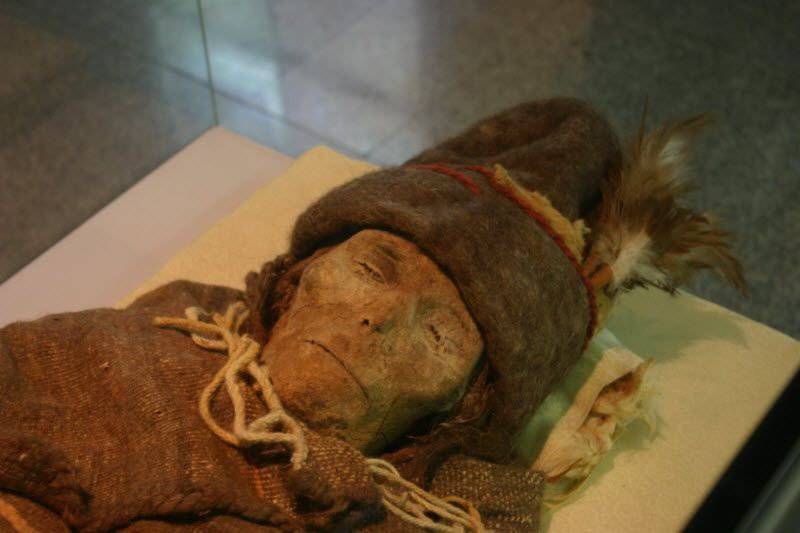
The language in which these people could speak is still the subject of controversy. But most scholars are inclined to believe that the language belonged to the group of Eastern Iranian languages, the so-called. Tokharian or agneo-Kuchansky. And the people themselves are part of the Indo-European community, known as the “Tochary,” or, more precisely, the “pseudo-tohary,” which may not be part of the historical Chinese Yuzhej.
But in any case, Chinese archaeologists found in the Tarim River basin paleographic inscriptions dated to a later period - 500-900 in the years AD. I draw attention to the well-distinguishable odious solar symbols in the text. As you know, various types of swastikas are already present on the ceramic ornament of the Andronovo archeological culture (Southern Urals of the Bronze Age), belonging to Indo-Iranian tribes, ancestors of historical Aryans, and with whom they identify the finds in the Tarim Basin.
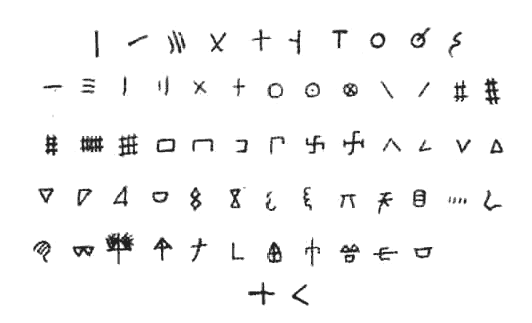
Images of notches from the Banshan, Machanyan and Matsyavan sites. 2.623-2.416 BC. By the way, in 2007, the genetic analysis of the remains of some well-preserved mummies was carried out by Li Jin, a geneticist from Fudan University.
He, among other things, found markers in the DNA of mummies, indicating their origin from East or even, perhaps, from South Asia, and in every possible way focused on this, which is simply paradoxical with the frank Caucasoid appearance of mummies.
To be fair, I will note (and I will express my personal thanks to the scientific principle to the scientist!) That common sense prevailed and recently Chinese researchers, led by Dr. Hui Zhou from Jilin University in Changchun, carried out a repeated genetic analysis of the Tarim mummies.
At the same time, a more plausible conclusion was made that these people had mixed origins: the researchers found European and Siberian genetic markers. All men, whose remains were analyzed, have found Y-chromosomes, which are characteristic of people in Eastern Europe, Central Asia and Siberia, but very rare in China. Mitochondrial DNA, which is transmitted through the female line, also points to Siberia and Europe. Since the found Y-chromosomes and mitochondrial DNAs are of ancient origin, Dr. Zhou concluded that the inhabitants of Europe and Siberia had intermarried, before coming to the Tarim basin about 4000 years ago. In general, it does not contradict the research of prominent Soviet Indo-Europeists Tamaz V. Gamkrelidze, who co-authored with another famous Soviet scientist Vyacheslav Ivanov, wrote a fundamental scientific work - "Idoevropeysky language and Indo-Europeans", which I highly recommend reading for anyone interested in the history of ancient Indo-Europeans.
Thus, with high probability, the findings in the Takla Makan desert should be correlated with the events of 2500 — 2000 BC. At this time, the Balkans spoke Proto-Greek, and in the Andronovo culture in the North Caspian steppes in the Proto-Indo-Iranian. The Bronze Age reached Central Europe along with the culture of bell-shaped cups, probably composed by various centum dialects. And the Tarim mummies, which we are especially interested in, are probably related to the culture of proto-Tocharians.
Immediately I draw the attention of an overly patriotic and simply zealous public, that the Slavs, as an ethnic group, have written descriptions within the framework of Byzantine sources IV (retrospectively) –VI centuries AD. Those. Attempts to attribute to the Slavs (Proto-Slavs) any significant events in Inner / Central Asia are a gross anachronism and lack all scientific basis.
Despite the considerable remoteness of the region from the generally recognized scientific centers and the ambiguous position of official China, in October 2009, the Swiss traveler Jean-Daniel Carrare and the archaeologist Christophe Baumer, also a Swiss, managed to get to Tacla Makan. The results of the expedition were shocking. Many graves are looted, local Uygurs are engaged in the grave digging and openly interfere with the work of the expedition. The ups and downs of this adventure journey, which can easily become the plot for the next Hollywood blockbuster, are colorfully described in the GEO magazine, #162 for September 2011 of the year.
So how could the Indo-Europeans get here? According to one of the hypotheses on the site of the Takla Makan desert, there was once a fertile valley, not inferior to the fertile climate and fertility of Feranskaya. Tugay groves of the Euphrates Poplar along the banks of rivers, lakes and marshes revived in ancient times the landscape of the Tarim Basin.
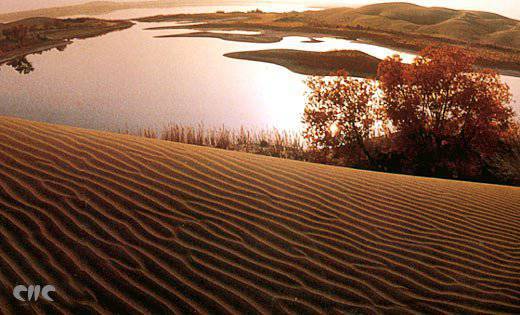
The Tarim River originates in the west of the Takla Makan desert and flows east. Now it no longer reaches the edge of the Tarim Basin and loses its waters in the sands. Until about 1200 BC. er More large tributaries flowed into the Tarim (including the Keriya River), so the river itself was much deeper and longer. Then the southern tributaries began to shallow and, finally, retreated from the Tarim. Today, Keria ends in the middle of the arid plain, where it forms the inner delta. The drying began most likely due to tectonic shifts that occurred as a result of earthquakes in the seismically active zone in the mountains on the southern border of Takla Makan, where the sources of the main rivers of the region are located.
So, the isolation and fertility of the soil could not fail to attract the ancient peoples here. Let me remind you that according to modern generally accepted views (“Kurgan hypothesis” by prominent Indo-Europeist Maria Gimbutas, 1956, and the more debatable “Armenian hypothesis” TVV.Gamkrelidze and V.V.Ivanova, 1984), the ancestral homeland of Indo-Europeans was the territory of the Northern Black Sea coast, in the area between the Dnieper and the Volga, or the territory of the Armenian Highland, and they themselves were the semi-nomadic population of the steppe regions of the modern eastern regions of Ukraine and southern Russia or the Armenian Highland, which lived in these places in the 5th – 4th millennium BC In addition, there is an even more controversial “Balkan theory”, also considered in the framework of academic science, but the author of the article considers it necessary to refer readers to the original source [Safronov V.A. Indo-European ancestral homeland], so as not to overload it.
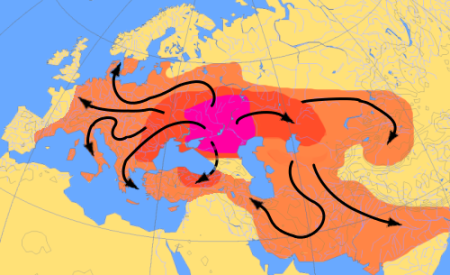
Thus, to the I millennium BC The Tarim Basin was probably settled by Indo-European tribes who spoke one of the Tocharian languages.
Where are these Indo-Europeans gone? It is believed that China played a significant role here. Yes, yes, that “peaceful colonizer”. And it is here that the name of the famous Shanyu (ruler) and the founder of the empire Hunn Maodun, better known as Mode, who lived in 234 — 174 BC, pops up. er Maodun led a sophisticated policy to win the territories conquered by the Qin Empire. Having entered into this alliance with the Chinese Han Empire, founded by Gao-Tzu in 202 BC.
Maodun defeated the Tochars and they had to flee. In retrospect, I note that according to one of the versions, the punitive expeditions of the Chinese emperor Xuan against the aggressive nomadic people of Chiung-nu led the entire Great Steppe to the colossal movement, which is reflected in the Assyrian documents dating the appearance of the Scythians in Central Asia during the reign of King Sargon (722 —705 years BC.). By the way, around the same time, the first group of Scythians consolidated in the southern part of Russia. That is why it can be considered that that period was the final stage in the movement of Asian tribes to the west, which formed the ethnocultural image of the Great Steppe until the formation of the Turkic kaganate and the military and religious campaigns of the Caliphate. Echoes of this large-scale “resettlement of peoples” are felt even today in interethnic conflicts by Iranian and Turkic-speaking people of Central Asia.
But back to the turn of our era. After the migration of the border Indo-European tribes, the Han Chinese quickly sounded the alarm: the Hun Empire was monstrously strengthened, and the western flank of the Celestial Empire was extremely naked in the face of hostile Western nomads. The messenger of the emperor with great difficulty found the nomads of the tohar who had fled, but they maliciously refused to return. In the courtyard stood 126 year BC. The remnants of the defeated Indo-Europeans rested in Fergana and fed the horses (not entirely by peaceful means, of course). After that, through the lands of the grace-filled Sogdians and Bactria they struck the north of Indostan. The result of the perfidious policy of the Han Empire was the formation of the grandiose Kushan kingdom (Kit. Guishuang), the most striking period of which was already in 105 — 250 AD.
And here "suddenly" a military aspect emerged (as always in human history). Or rather - horses. The fact is that in ancient times, the territorial expansion was simply impossible without the use of "living machines" - the mounts and mounts. But, after all, bad luck! - The nature has cheated the middle empire here - China did not know normal racers. All that they had was little peaceful konyashki, more similar to English ponies, on which our children now ride with such pleasure. Judge for yourself - here are photos of famous terracotta statues from the tomb of Emperor Qin Shi Huang. All the statues in the burial are made in full size. Just look at these martial Chinese racers. Laughter, and more!
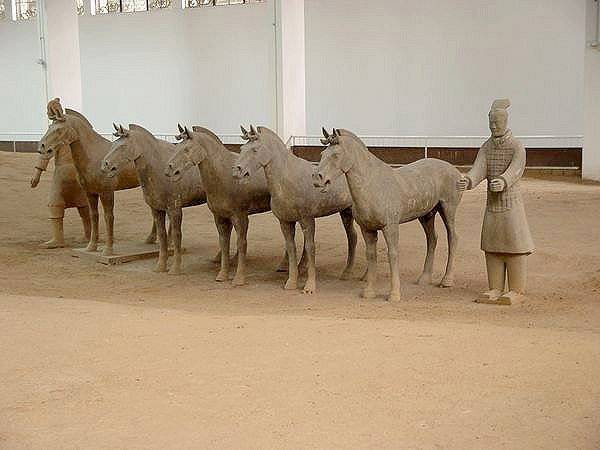
And, behold, the Chinese were in such a state of affairs (it was difficult to fight with nomads on such “horse substitutes”) finally “baked out”. It was necessary to do something and the Chinese decided on another grand adventure - again to go to East Turkestan and then to Fergana. For Fergana horses. Horses that cost more than gold. "Heavenly" horses of Fergana. These are the handsome ones:
As seen in the photo, the famous Fergana horse has a tall stature, a muscular lean article and a long neck with a rather small head. But this is not an invention of Sogdov. This breed is the result of crossing of the Arabian breed horses brought from Central Asia and the Fergana Valley with short, but hardy Mongolian horses. And this breed did not appear in Fergana at all - the first finds of horses of this kind belong to the 6th-4th centuries. BC and located in the Scythian-Sarmatian burials in the Urals and Altai. You understand that in the first century BC, the Urals for the Chinese civilization was akin to the mythical Hyperborea - monstrously far, monstrously cold, monstrous tribes with dog heads and dragon tails, who are waiting to feast on delicious Chinese flesh (joke).
In short, it was decided to go to war precisely in the fertile and relatively close to Fergana.
By order of the ambitious emperor Shihuandi, the renowned Han commander Li Guang-li made two attempts to make his way through East Turkestan to Fergana. The first one (in 104 in 102 BC) ended unsuccessfully - only a third of the soldiers of his army returned to Dunhuang, even before reaching the Fergana Valley. The rest died of hardship, famine and clashes with hostile tribes in the area of Lob Nor.
The Han emperor was furious and ordered to send a second expedition. In 102 BC, around 60, thousands of well-equipped army troops, led by valiant General Li Guang-li, took to the road again. By monstrous deprivations, they managed to reach the capital of Fergana. The Chinese laid siege to the city and took the water from Ershi. As a result, the aristocracy of the city decided to give several thousand Fergana horses, but on the condition that the Han troops did not enter the city and refrain from robbery and violence. China licked but took the herds with him and went back to the Middle Empire.
Inspired by the successful acquisition, the Chinese did not abandon their attempts to seize the lands of Eastern Turkestan, but here they managed to take revenge on the descendants of Yuechzha and at the end of the first to the beginning of the second century AD er - the reign of the famous Kushan king Kanishka I - his army managed to stop the Han expansion in East Turkestan and even further to the west.
The course of history is relentless in the III century AD the Kushans had already been defeated by Sasanian Iran, and their mighty kingdom began to crumble.
In the 5th century, the Kushan statehood was finally destroyed by the “White Huns” - Ephtalites.
According to the most popular version, the Ephtalits were an ancient Turkic people, but the question of their ethnic origin remains open. Some researchers are inclined to believe that the East-Iranian or mixed (Sogda and Tokhara) origin of this people.
In any case, the conquest of the Kushan kingdom by the Huns accelerated the Turkization of the region and formed the image of Inner Asia for many centuries.
Under the combined blows of the Sassanian Iran and the Turkic Kaganate, the Ephtalits were defeated in the general battle in 565 near the city of Karshi. According to the results of the battle, the border between Iran and Kaganat was drawn along the Amu Darya.
China gloatingly exulted and made plans, but not for long, although the liquidation of a large border state gave it a reason to increase its military presence in East Turkestan and Central Asia.
At the same time, at the beginning of the 7th century, the Arab Caliphate, which was gaining power, inflicted a crushing defeat on its main opponents - the Byzantine Empire and the Sassanid Empire - and began its expansion into Central Asia. The moment of the collision of the Middle Empire and the Abbasid Caliphate became a simple matter of time.
The prerequisite for the military clash was that in 749, the Chinese commander Gao Xianzhi stormed Tashkent, executing his Turkic ruler Mohad.
The caliph's viceroy in Central Asia ordered troops to be sent to repel the invasion, the result of which was a grand battle in the summer of 751 on the Talas River in present-day Kyrgyzstan. Because of the betrayal of the part of the Allies, on the fifth day of the positional battles, the Karluk cavalry forces struck the rear of the imperial army. Under the combined blows from the two sides, the Chinese army wavered and turned into a total escape. Convoy Gao Xianzhi with great difficulty paved the way for the commander among the panic-ridden soldiers and saved his life.
The results of the grand battle have become epochal for the region and their consequences should not be underestimated. The battle put an end to the advance of the borders of the Tang Empire to the west. At the same time, the Chinese commanders managed to inflict quite significant damage to the Arab forces, which stopped their advancement to the east, in Semirechie, on the lands of the Turgesh Kaganate, slightly delaying the fall and final Islamization of King Devashtich after the fall of the fortress on Mount Mug in 722 under blows troops of the Khorasan Emir. However, a few years after the Talas battle, An Lushan's grand uprising began, which sharply undermined the power of Tang China and forced the emperor to withdraw its border garrisons to the east, forgetting about China’s expansion to the west for long 1000 years. Turkization and Islamization of Central Asia and East Turkestan became inevitable, predetermining the history of the region for many centuries.
After that, in fact, the long and tragic Uygur period begins in East Turkestan. According to the modern classification, three Uygur kaganates are distinguished, the second of which was destroyed by the Turkic kaganate in 603, and the third was erased from the face of the earth in about 840 by Kyrgyz from the Yenisei.
The Uygur shards fled to Turfan and Gansu. The civilization role of the Uygurs lies in the fact that they, and not the Han Chinese, began the transition in the region to settled farming.
After the Karakhanid, Karakitay, and long Mongolian period, the Uigurs underwent a strong Jungar influence. After the collapse of the Qing Empire, during which the Uighurs were subjected to mass extermination, the period of national liberation movement began. This period is so large that it does not fall within the scope of this publication. I will say briefly that, starting from the first years of the 20th century, the Uygur uprisings constantly shook the region. This process continues today, albeit on a smaller scale.
However, I note that the ancient defeat of Gao Xianzhi did not cause China’s final rejection of Eastern Turkestan, the logical outcome of which was the final seizure of Eastern Turkestan in the late 40-s of the last century and the formation of Xinjiang-Uygursky Autonomous Region in 1955.
In the middle of the 19th and the beginning of the 20th century, the myth of the formidable “Russian steam rink” was popular in the West, which by countless hordes of “wild Cossacks” is capable of rolling Europe into a pancake. Historically, Europeans, and later Americans, looked at China with arrogant disregard. Historical retrospectives allow us, the inhabitants of Eurasia, to condescendingly look at modern "Euro-Americans" with their snobbery in matters of geopolitics.
However, the activation of the national movement (not without the help of the West, of course) in East Turkestan suggests that everything will change soon. "Chinese steam rink" is stored coal.

Information